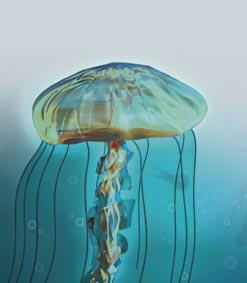Jellyfish, summer visitors

Run! Hide! We may not have any sharks, but these fellas can be just as vicious, says Éanna Ní Lamhna
Nothing strikes terror into the heart of a swimmer in Irish waters more than the call of "jellyfish!" or the sight of one of these beautiful, pulsating, umbrella-like creatures oscillating past. (Yes, I know a shark might be worse, but you won't encounter sharks while swimming off our coast as it is too cold for them to feed at these latitudes.) Of course, it is not the jelly part of the jellyfish that does the harm, but the almost invisible tentacles trailing along behind.
A jellyfish is a very primitive animal – it has no blood system or excretory system. It has a saucer-shaped, jelly-like body and several mouths that hang like arms under the body as it floats in the sea. These mouths are surrounded by stinging tentacles, which paralyse any creature that may be in the vicinity. They are then swept into the mouths as food. Jellyfish may also have tentacles hanging in a circle all around the perimeter of their body as extra stinging cells.
Washed up on the shore, the usual one seen on a walk along the high-tide mark is the common jellyfish (pictured below). This has a transparent body up to 25cm in diameter with four blue circles. Even if it is dead, the tentacles can retain their stinging ability for some time, so don't go poking at it with your bare hands.
The Lion's Mane jellyfish is a much larger animal, and orange-yellow in colour. It can be up to 50cm across, with large mouth-arms and lots of vicious tentacles. So many Lion's Mane jellyfish came onto Dublin's beaches last year that they were closed for a period. There have only been one or two sightings so far this year.
Swimmers along the southwest coast may also encounter an even more dramatic creature – the Portuguese Man-of-War. It has a large and conspicuous float – for all the world like a sail – above its silver blue body, which can be 30cm long. Its stinging tentacles can can be up to 20m long and they are able to inflict horrible stings all along their length. If their tentacles are cut off, say by the propeller of a boat, they will still give a swimmer a nasty sting across the face, and the victim cannot see them to avoid them.
In turn, however, jellyfish are food for turtles. One of the signs of global warming is the arrival of turtles in our waters in summer. Mind you, we only see them when they become entangled in fishing nets, as they live and feed in deep water. But occasionally, one is washed ashore dead – quite often the cause of death is the ingestion of a plastic bag which it mistook for a jellyfish. Let's hope that the plastic bag levy will cut down on such accidents in our territorial waters in future.
